 |
||||||
| HOME | A BIT ABOUT BUGS | GALLERY | SYSTEMATIC LISTS | RECORDING BUGS | CONTACT US | LINKS |
| Gallery pages in progress........please use the systematic lists to browse all species |
||||||
Family Aradidae (Flatbugs) |
||||||
Bugs in this family are extremely flattened and well-suited to living under bark; they feed on fungi and are often associated with dead trees and rotting wood. There are 7 species in the UK. |
||||||
 |
 |
 |
 |
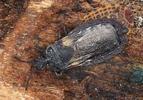 |
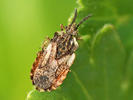 |
 |
- Usually fully-winged (macropterous) - Antennae with 4 segments - Tarsi with 2 segments - Ocelli absent |
||||||
|
Superfamily Pentatomoidea (Shieldbugs) |
||||||
Represented by around 30 species and 4 families in mainland Britain, shieldbugs are flattish oval or shield-shaped bugs which have a large scutellum, usually reaching the wing membrane. Many are large, colourful and distinctive, although the larval instars are more difficult to identify. They are known as stink bugs in the USA due to their ability to emit noxious chemical defences when threatened. While many species feed only on plants (phytophagous), a few are entirely predatory. Most spend the winter hibernating as adults. |
||||||
 |
 |
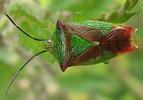 |
 |
 |
 |
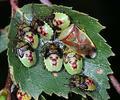 |
- Fully-winged (macropterous) - Antennae with 5 segments - Tarsi with 2 or 3 segments - Ocelli present - Scutellum large and often triangular |
typical outlines of shieldbugs > (p = pronotum, s= scutellum) |
 |
||||

|
< Shieldbug lifestage charts | |||||
|
Family Coreidae (Squashbugs) |
||||||
Squashbugs are generally brownish in colour and longer and more elongated than shieldbugs. The abdomen is often broad and laterally expanded. There are 10 species in the UK; most are confined to the south and only two are classified as common. They feed mainly on fruits and seeds and also possess stink glands. They are particularly associated with sparsely-vegetated or bare ground habitats. All overwinter as adults. |
||||||
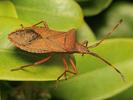 |
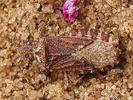 |
 |
 |
 |
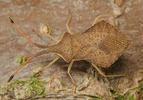 |

|
- Fully-winged (macropterous) - Antennae with 4 segments - Tarsi with 3 segments - Ocelli present |
||||||
 |
< Squashbug lifestage charts | |||||
|
Family Alydidae (Broad-headed bugs) |
||||||
Closely related to the Coreidae, this is a small and mainly tropical family. In the UK it is represented only by Alydus calcaratus, a large dark bug found mainly on heathland. The 4th antennal segment is curved and the hind femora bear several spines. |
||||||
 |
 |
|||||
- Fully-winged (macropterous) - Antennae with 4 segments - Tarsi with 3 segments - Ocelli present |
||||||
|
Family Rhopalidae (Rhopalid bugs) |
||||||
This family is closely related to the squashbugs and consists of 11 species. They are characterised by largely membranous and transparent forewings, with numerous veins in the apical region, and are often hairy. Most are broadly oval in shape, although two species are rather elongate and superfically resemble grass bugs (Miridae). All are phytophagous, feeding on low plants and grasses and the majority overwinter as adults. |
||||||
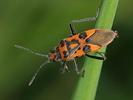 |
 |
 |
 |
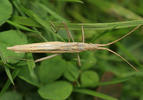 |
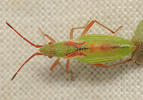 |
 |
- Macropterous or brachypterous (partly-winged) - Apical wing membrane with numerous veins - Antennae with 4 segments - Tarsi with 3 segments - Ocelli present |
||||||
|
Family Stenocephalidae (Spurgebugs) |
||||||
Allied to both the squashbugs and groundbugs (Lygaeidae), this family consists of only two species in the UK, both of which feed on spurges (Euphorbia). Large and purple-brown in colour, the antennae and legs are marked with dark and light bands. Both overwinter as adults. |
||||||
 |
 |
 |
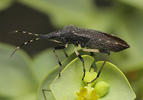 |
|||
- Macropterous - Antennae with 4 segments - Tarsi with 3 segments - Ocelli present |
||||||
|
Family Pyrrhocoridae |
||||||
Closely allied to the (Lygaeidae), this family is represented by only one species in the UK, the Firebug, a striking red and black species which is very rare and confined to a few localities in southern England. |
||||||
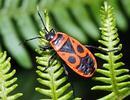 |
 |
|||||
- Brachypterous - Antennae with 4 segments - Tarsi with 3 segments - Ocelli absent |
||||||
|
Family Lygaeidae (Groundbugs) |
||||||
These mostly dark brown and black bugs form the second largest Heteropteran family in the UK. Although several species are associated with trees and shrubs, most are ground-dwelling and are usually found at ground level or close to it. The majority feed on plants, particularly seeds, although some are partly predatory. Almost all overwinter as adults. |
||||||
 |
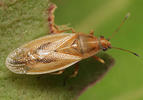 |
 |
 |
 |
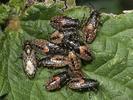 |
 |
- Macropterous or brachypterous - Apical wing membrane with 5 or less roughly parallel veins - Antennae with 4 segments - Tarsi with 3 segments - Ocelli present |
||||||
|
Family Berytidae (Stiltbugs) |
||||||
These bugs are slow moving insects with long and thin legs. The tips of the femora are usually swollen and the last antennal segment is clubbed. |
||||||
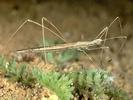 |
 |
 |
||||
- Macropterous - Apical wing membrane with 5 or less roughly parallel veins - Antennae with 4 segments - Tarsi with 3 segments - Ocelli present |
||||||
|
Family Piesmatidae (Beetbugs) |
||||||
These small bugs have reticulated forewings which recall the Tingidae (lacebugs), but the pronotum does not project backwards covering the scutellum and there is a definite apical wing membrane. They feed on plants in the Chenopodiaceae; only 2 species in the UK. |
||||||
 |

|
 |
||||
|
Family Tingidae (Lacebugs) |
||||||
These small bugs are commonly known as lacebugs, due to the intricate meshed and lace-like reticulation of the pronotum and forewings, which are sometimes covered in waxy deposits. There is often little or no distinction between the corium and the wing membrane. The pronotum projects backwards and covers the scutellum. All feed on plants and are often very host-specific. |
||||||
 |
 |
 |
 |
 |
 |
 |
| - Macropterous or brachypterous - Antennae with 4 segments - Tarsi with 2 segments - Ocelli absent |
||||||
|
Family Reduviidae (Assassin bugs) |
||||||
Assassin bugs are long-legged predatory bugs with a prominent curved rostrum, used to feed on a wide range of other insects. Some species are very thin and thread-like, while others are much more compact. This is predominantly a tropical family, represented by only 7 species in the UK. |
||||||
 |
 |
 |
 |
 |
 |
 |
- Prominent 3-segmented curved rostrum - Macropterous or brachypterous - Antennae with 4 segments; long 1st segment - Tarsi with 3 segments - Ocelli present |
||||||
|
Family Nabidae (Damsel Bugs) |
||||||
Nabids (Damsel bugs) are large long-legged predatory bugs with a prominent curved rostrum. They have 4 antennal segments and are generally some shade of brown in colour. Many are partly-winged as adults (brachypterous). There are 12 species in the UK, and many of these can be found commonly in a variety of habitats. Although superficially similar to the assasin bugs (Reduviidae), they are much less bristly, the rostrum is 4-segmented and the 2nd antennal segment is always the longest. Most overwinter as adults. |
||||||
 |
 |
 |
 |
 |
 |
 |
- Prominent 4-segmented curved rostrum - Often partly-winged (brachypterous) - Antennae with 4 segments; 2nd the longest - Tarsi with 3 segments - Ocelli present |
||||||
|
Family Miridae (Plant bugs) |
||||||
Mirid bugs, often known as capsids or plant bugs, comprise by far the largest family within the Heteroptera, representing over a third of all UK species. They are mostly rather delicate insects which feed on plants, although a number are wholly or partly predatory. The vast majority spend the winter as eggs. |
||||||
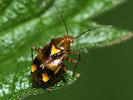 |
 |
 |
 |
 |
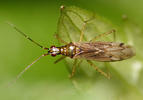 |
 |
- Forewings usually with two closed cells - Macropterous or brachypterous - Antennae with 4 segments - Tarsi with 3 segments - Ocelli absent - Prominent cuneus |
||||||
|
Family Saldidae (Shorebugs) |
||||||
Saldids are mostly rather flat and dark oval bugs with whitish markings. The wing membrane has 3-5 closed cells. They are predatory and have very large eyes and can run fast and fly readily. Almost all of the 20 or so species are characteristic of wetland environments (both freshwater and saline). |
||||||
 |
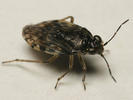 |
 |
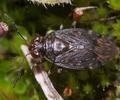 |
 |
 |
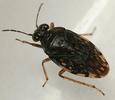 |
- Large eyes - Forewings with 4-5 closed cells - Macropterous or brachypterous - Antennae with 4 segments - Ocelli present |
||||||